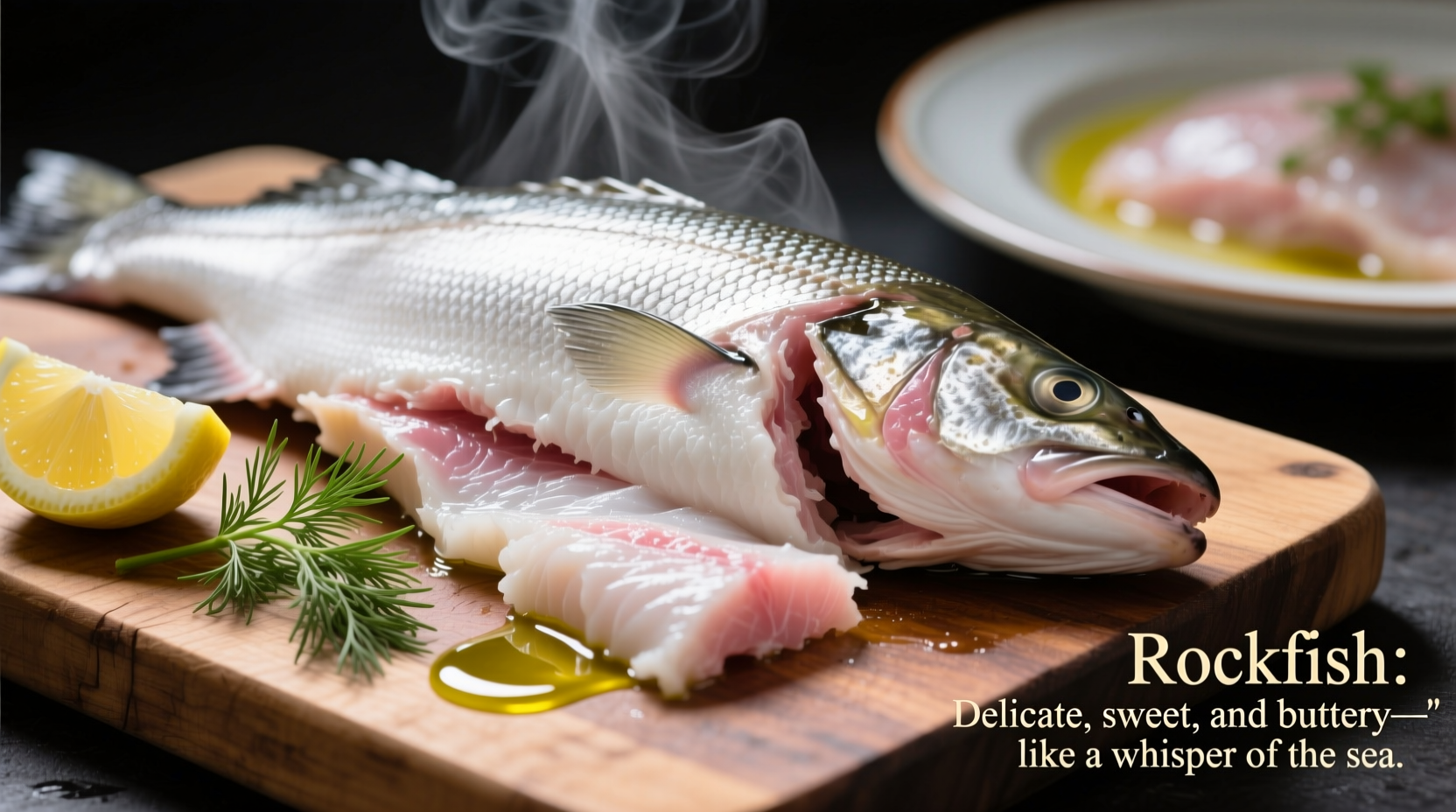Ever wonder whether rockfish should be your next seafood choice for dinner? Understanding exactly what does rockfish taste like can transform your cooking experience and help you make informed decisions at the seafood counter. This comprehensive guide delivers precisely what you need to know about rockfish flavor profiles, texture characteristics, and how to prepare it for optimal taste—whether you're a seafood novice or an experienced home cook.
Rockfish Flavor Profile: Beyond the Basics
Rockfish delivers a clean, mild ocean flavor that's substantially less “fishy” than many other species. The subtle sweetness in its flavor profile makes it exceptionally versatile in the kitchen. Unlike stronger-tasting fish like mackerel or bluefish, rockfish won't dominate your dish with overwhelming seafood notes. Instead, it provides a perfect canvas for sauces and seasonings while maintaining its own delicate character.
When evaluating what does rockfish taste like compared to cod, you'll notice rockfish has slightly more complexity—a hint of nuttiness that cod lacks—while maintaining similar flakiness. Compared to halibut, rockfish offers a more delicate flavor that won't stand up to heavy smoking but shines when pan-seared or baked with simple seasonings.
Texture Characteristics That Matter for Cooking
The texture of properly cooked rockfish is where it truly excels. Its firm yet tender flakes separate cleanly without becoming mushy—a quality that makes it ideal for fish tacos, chowders, and salads where you want distinct fish pieces. When cooked correctly, rockfish maintains moisture exceptionally well, resisting the dryness that often plagues other white fish varieties.
Food scientists at the NOAA Fisheries have documented that rockfish contains moderate fat content (approximately 2-3%) distributed evenly throughout the flesh, which contributes to its moist texture even when cooked to proper internal temperatures of 130-135°F (54-57°C).
Rockfish Compared to Popular White Fish Varieties
| Fish Variety | Flavor Intensity | Sweetness Level | Best Cooking Methods | Substitution Ratio |
|---|---|---|---|---|
| Rockfish | Mild | Moderate | Pan-searing, baking, poaching | 1:1 for snapper or cod |
| Cod | Very mild | Low | Frying, baking, steaming | 1:1.25 for rockfish |
| Snapper | Moderate | High | Grilling, roasting | 1:0.75 for rockfish |
| Halibut | Moderate | Moderate | Grilling, pan-searing | 1:0.9 for rockfish |
This comparison helps answer the common question: is rockfish mild or strong tasting? As you can see, it sits comfortably in the mild-to-moderate range, making it accessible for those who prefer less intense seafood flavors while still offering more character than extremely mild options like cod.
When Rockfish Shines—And When to Choose Alternatives
Understanding the context boundaries for rockfish helps you make better culinary decisions. Rockfish performs exceptionally well in:
- Dishes requiring delicate flavor balance like fish tacos with citrus slaw
- Casseroles and bakes where you want fish to absorb surrounding flavors
- Pan-seared preparations with light herb sauces
- Seafood soups and chowders where distinct fish pieces are desired
However, consider alternatives when:
- You need a fish that can withstand heavy smoking (try salmon instead)
- Your recipe requires extremely firm flesh for kebabs (swordfish works better)
- You want pronounced seafood flavor to dominate the dish (sea bass might suit better)
According to culinary research from the OSU Seafood Research Extension, rockfish's moderate fat content makes it particularly vulnerable to overcooking—a critical factor that affects its final taste profile. When cooked beyond 140°F (60°C), rockfish loses its delicate sweetness and develops a slightly metallic aftertaste that many diners find unpleasant.

Maximizing Rockfish Flavor: Proven Cooking Techniques
To experience the best what does fresh rockfish taste like has to offer, follow these chef-recommended techniques:
Dry-Brining for Enhanced Flavor
Apply a light coating of salt (about 1 teaspoon per pound) to your rockfish fillets and refrigerate uncovered for 20-30 minutes before cooking. This simple technique, validated by food science research at UC Davis, helps the fish retain moisture while enhancing its natural sweetness without adding saltiness.
Pan-Seared Perfection
For the ideal texture when you're wondering what does rockfish taste like when cooked properly:
- Pat fillets completely dry with paper towels
- Heat neutral oil (like grapeseed) in a stainless steel pan until shimmering
- Place fish skin-side down (if skin-on) and press gently for 10 seconds
- Cook undisturbed for 3-4 minutes until skin crisps
- Flip and finish cooking for 2-3 minutes until internal temperature reaches 130-135°F
Flavor Pairings That Complement Rockfish
Rockfish's delicate flavor works beautifully with:
- Citrus elements (lemon, lime, orange) that enhance its natural sweetness
- Light herb sauces featuring dill, parsley, or chives
- Mild aromatics like fennel, leeks, and shallots
- Buttery sauces with a touch of white wine
Avoid overpowering spices or heavy sauces that would mask rockfish's subtle flavor profile. When experimenting with best seasonings for rockfish, remember that less is often more with this delicate fish.
Regional and Seasonal Flavor Variations
Did you know that what does rockfish taste like can vary significantly based on where and when it's caught? According to the National Oceanic and Atmospheric Administration, rockfish from colder northern waters (like the Pacific Northwest) tend to have slightly higher fat content, resulting in a richer flavor profile compared to southern varieties.
Season also affects taste. Spring-caught rockfish typically has the most delicate flavor as fish haven't expended energy on spawning. Fall harvests often yield slightly stronger-flavored fish as they prepare for winter. This seasonal variation explains why many chefs consider spring the optimal time for experiencing rockfish at its flavorful best.
Common Flavor Myths Debunked
Several misconceptions persist about rockfish flavor. Let's address the most common:
Myth: All rockfish tastes the same regardless of species
Reality: With over 100 rockfish species, flavor varies considerably. Yelloweye rockfish offers a richer taste than the milder Bocaccio variety.
Myth: Rockfish always has a strong “fishy” taste
Reality: Properly handled and fresh rockfish has minimal fishiness—often less than cod. Any strong fishy taste indicates improper handling or age.
Myth: Rockfish can't stand up to bold flavors
Reality: While delicate, rockfish pairs beautifully with medium-intensity flavors like tomato-based sauces, mild curries, and pesto.
Ensuring You're Tasting Quality Rockfish
The flavor experience of rockfish depends heavily on freshness and handling. When selecting rockfish, look for:
- Firm flesh that springs back when pressed
- Clear, bulging eyes (for whole fish)
- A clean ocean scent, not fishy or ammonia-like odors
- Moist, shiny appearance without dry spots
The Monterey Bay Aquarium Seafood Watch program recommends choosing rockfish from well-managed fisheries to ensure both sustainability and quality. Their research shows that properly handled rockfish maintains optimal flavor for 1-2 days after catch when stored at proper temperatures.











 浙公网安备
33010002000092号
浙公网安备
33010002000092号 浙B2-20120091-4
浙B2-20120091-4